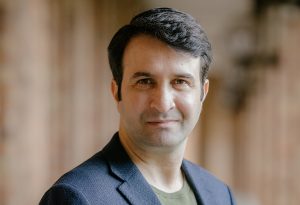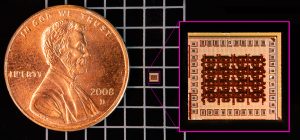Article by Wayne Gillam, photos by Ryan Hoover / UW ECE News

UW ECE Assistant Professor Hossein Naghavi directs the Terahertz Integrated MicroElectronics Lab at the UW, where he designs microchips that use high frequency terahertz electronics built using a combination of integrated circuit design and electromagnetics techniques.
Nestled between the microwave frequencies commonly used in cell phones and higher frequencies used in optical technologies is a new frontier — a range of electromagnetic waves known to scientists and engineers as the “terahertz band.” Wave frequencies in this band span 100 gigahertz to 10 terahertz, and until recently, they were passed over when it came to using them in electronic devices. In fact, the terahertz band was once called the “terahertz gap” because of the difficulty in generating and detecting these frequencies. However, advancements in technology over the last 25 years have allowed engineers to explore terahertz frequencies and their potential applications.
UW ECE Assistant Professor Hossein Naghavi has dedicated his career to exploring terahertz frequencies and applying his discoveries to electronics. More specifically, he develops electronics and integrated circuit designs that use frequencies above 100 gigahertz for imaging, sensing, and communication.
“Terahertz frequencies have opened a plethora of unique applications in the fields of sensing, spectroscopy, imaging, and communications,” Naghavi noted in the introduction to his UW ECE Research Colloquium talk. “The short wavelength, see-through capability, and availability of wide bandwidth in the terahertz band make it an essential player for high-resolution sensing and imaging and high-speed communication networks.”
Naghavi’s work with terahertz frequencies requires a deep understanding of circuit design and electromagnetics as well as the complex physics and mathematics that underpins both of these domains. It is a knowledge base he has built through years of study and scholarship.
Combining integrated circuit design and electromagnetics

A microchip designed in Naghavi’s lab, placed next to a penny. The inset box shows a closeup view of this tiny chip.
Growing up in Ghaen, Iran, Naghavi first became interested in electrical engineering when he was in high school and his uncle made a walkie-talkie for fun. Naghavi was intrigued with the device, and he wanted to learn how it worked. He was a good student and had an interest in studying electrical engineering at the university level, so after high school, he attended the Amirkabir University of Technology. There, he became fascinated with the intersection of electronics and electromagnetics and pursued studies in both areas. In 2009, he received his bachelor’s degree in electrical engineering and then went on to graduate school, where he focused on applied electromagnetics. In 2013, he received his master’s degree in electrical and computer engineering from the University of Tehran.
Naghavi came to the United States to pursue his doctoral degree at the University of Michigan, which has one of the strongest programs in the nation in applied electromagnetics. His doctoral work was aimed at bringing together techniques from circuit design and electromagnetics to build terahertz integrated circuits. As a research scholar, he contributed to the development of the first fully integrated terahertz inverse synthetic aperture radar imaging system. In 2023, he graduated from the University of Michigan with his doctoral degree in electrical and computer engineering. Naghavi noted the value of bringing circuit design and electromagnetics together.
“In my research area, which is terahertz circuit design, the frequency is so high that the circuit models are not accurate enough,” he said. “We need to use those electromagnetic tools to make sure our designs are accurate.”
“I would say that the best time for me during the week is when I’m in the class and teaching my students. I really like explaining these topics to students to help them understand.” — UW ECE Assistant Professor Hossein Naghavi
Naghavi joined UW ECE in September 2023. When looking for a faculty position, he said he was interested in the UW because of the University’s long-standing reputation in electromagnetics. Many big names in this field, such as UW ECE Professor Emeritus Akira Ishimaru, have been faculty at the UW and wrote textbooks Naghavi read during his undergraduate and graduate studies. Naghavi said he was also attracted to UW ECE because it is a dynamic place that has ample resources, a large number of assistant professors conducting cutting-edge research, and outstanding students. He noted that the UW encourages and supports collaboration between faculty within UW ECE and across departments.
“One recent proposal I was a part of involved combining research from people who work in a nanofabrication lab with people that have knowledge in AI and machine learning and people that work in the communication domain,” Naghavi said. “We combined our ideas and proposed new communication systems that can resolve some of the fundamental challenges that we have with the next generation, 6G communication network. Without this kind of collaboration, it’s impossible to create a comprehensive approach to broad problems such as this one.”
Applications for high frequency electronics
Naghavi directs the Terahertz Integrated MicroElectronics Lab at the UW, where he designs microchips that use high frequency terahertz electronics built using a combination of integrated circuit design and electromagnetics techniques. His main research focus is to design microchips for high-resolution and high-precision imaging, but the chips he develops have many potential applications in sensing and communication as well. Listed below are a few use cases for the terahertz electronics Naghavi is building in his lab:
Enhancing human perception
Terahertz frequencies enable the user to see through optically opaque materials, both at close range and up to a couple of meters away. The chips being developed by Naghavi are designed to enable precise and real-time detection of still or moving objects in the environment. Achieving this requires sophisticated, integrated, on-chip systems capable of performing localization, material characterization, and high-resolution imaging. Naghavi’s ultimate goal is to develop a portable terahertz transceiver that can serve as either a compact sensory organ that enhances human perception, or, on an industrial scale, a device that systematically creates detailed material maps for object detection and classification in any setting. When integrated into augmented reality hardware, this technology has the potential to transform how the user interacts with the world. For example, a firefighter could use a terahertz-enabled AR headset to see through smoke and flames, identify hazards like high-voltage cables, and locate trapped individuals, leading to safer and more effective rescue operations. Similarly, a nurse could use terahertz vision to non-invasively monitor the healing progress of a covered wound, assessing tissue health without removing bandages and risking infections. These are just two among many possible ways this technology could enhance human perception and provide critical information in challenging environments.
Medicine
Terahertz frequencies could replace X-rays for common medical procedures, such as dental scans. Like X-rays, terahertz frequencies can be used to see cavities, root canals, and other dental features. However, there is no danger to the dentist or patient because the photons in terahertz frequencies are much lower energy than the photons in X-rays. Unlike X-rays, terahertz frequencies don’t cause cancer or DNA mutation, so they are safe to use around people. Terahertz frequencies could also be used to detect production defects in pharmaceuticals. The thickness of pharmaceutical capsules needs to be uniform and accurate, and terahertz frequencies could help with measurements and detecting defects in these capsules. In addition, the unique ability of terahertz frequencies to resonate with macromolecules, such as proteins and DNA, could create new opportunities for cancer cell detection and medical research.
Communication networks
The technology Naghavi is engineering is applicable to high-speed communication networks, including the next-generation 6G communication network, which is now in development. More specifically, this technology applies to backhaul communication networks, which connect end-users and access points, such as cell towers, to larger core networks, or “backbones” of the communication system. Current backhaul communication networks rely heavily on fiber optics, which provides high-speed data transfer between backbone networks. However, fiber-optic technology has challenges, such as requiring the burial of fiber-optic cables deep underground. In contrast, terahertz frequencies can deliver wireless, point-to-point networks with communication speeds comparable to those of fiber-optic technology. This feature is achieved because of the availability of wide bandwidth in the terahertz domain and the fact that terahertz waves can travel through inclement weather, such as fog, rain, and snow. Backhaul communication systems using terahertz frequencies can operate at close to the same speeds as those using optical frequencies, but with fewer infrastructure requirements, making terahertz frequencies a promising and potentially more affordable solution for high-speed backhaul communication networks.
Electronic sensing
In electronic sensing, Naghavi is exploring “surface screening techniques,” which are ways of using terahertz frequencies to detect microscopic defects in otherwise smooth surfaces. These techniques could be useful in manufacturing processes that require the production of a smooth surface, such as in the semiconductor industry, where precisely measuring the thickness of deposited layers on substrates, like silicon, is crucial. Also, terahertz frequencies could be used in ophthalmology to augment or replace standard ultrasound pachymetry — a test that measures the thickness of the cornea (the clear, front part of the eye). Pachymetry requires contact with the eye to measure the central and peripheral corneal thickness. In contrast, terahertz frequencies could be used to non-invasively monitor corneal thickness. Naghavi said he believed other new sensing applications for this technology will appear in the future as scientists and engineers develop more integrated circuits that adopt terahertz frequencies.
Providing unique opportunities for students

A photo of the same chip pictured above, shown here on the black-and-white grid next to coins, paperclips, coffee beans, rice, a guitar pick, ruler, and pencil.
Investigating ways to apply terahertz frequencies to electronics can be a deep dive into physics, mathematics, circuit design, and electromagnetics. Naghavi said he is committed to this complex work because the problems engineers are facing today are so hard that innovation is required. He noted that classical engineering techniques by themselves cannot solve the problems occurring in today’s applications. He also said that those building commercial products generally don’t have the time or flexibility to explore new research and techniques like what he is focusing on at UW ECE. New approaches require innovation and experimentation, which is a strength of academia.
With that in mind, Naghavi is developing high frequency electronics by exploring new ideas, theories, and techniques derived from physics and mathematics and implementing them in microchips that are built using traditional fabrication methods. By doing so, he aims to leapfrog over existing technology and significantly improve chip performance. His main industry collaborator is STMicroelectronics. This company helps to support research opportunities for students in his lab. Naghavi is also incorporating advanced electromagnetics courses into UW ECE curriculum, which provide important knowledge for students who want to design high-frequency terahertz chips. Chip fabrication courses have also been recently introduced in the Department.
“We are developing new physics and mathematics for these high-frequency devices that we create. All of my doctoral students use this knowledge to design their circuits with simulation tools. We then fabricate the chip and show that the idea we have works,” Naghavi said. He added, “It used to be that only after one to three years of doctoral-level studies, would a student be ready to do a ‘chip tape out,’ which means to fabricate a chip. But now, we are offering this experience to undergraduates, which is highly advanced and a unique opportunity.”
Naghavi teaches and advises a mix of undergraduate and graduate students. He recommends to his undergraduate students that they seek to achieve a deep and comprehensive understanding of the topics they study, as this knowledge is foundational. For his graduate students, he recommends they study the field’s literature as well as open-ended problems engineers are trying to solve. Naghavi also said that creating a welcoming and inclusive environment for all students is important to him. To that end, he is part of the Inclusive Excellence Faculty Fellowship Program in the UW College of Engineering, which helps faculty design undergraduate courses to make them accessible for people from diverse backgrounds.
“I would say that the best time for me during the week is when I’m in the class and teaching my students,” Naghavi said. “I really like explaining these topics to students to help them understand. The students also motivate me to continue to build my own knowledge, because when you want to explain a new topic to a person who doesn’t have any background in this area, you should understand that topic at a deep level.”
For more information about UW ECE Assistant Professor Hossein Naghavi, visit his UW ECE bio page and the Terahertz Integrated MicroElectronics Lab website.

